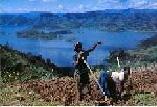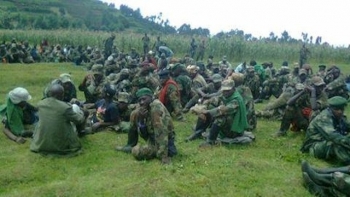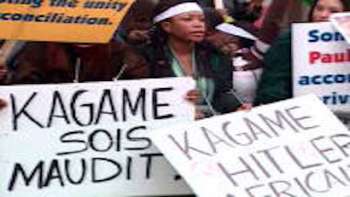Being an ignorant in economics matters, I approached my friend Dr. Felicien Kanyamibwa who is a statistician and econometrician and a Rwandan expert to explain the discrepancies in the Rwandan GDP and economic growth numbers. I was trying to understand the discussions between two Rwandans:
One, Dr. Ngarambe Joseph, who claimed to be a Rwandan Expert Economist and another Rwemalika, apparently a Rwandan government official, on a Rwandan discussion group. As you may see below, Dr. Kanyamibwa Felicien shows that these statistics the Rwandan government is publishing, to reinforce its case of unparalleled development, do not make sense at all and that Dr. Ngarambe may be right. Here is his answer (if you hated math in High School, please stop here !!!!).
David,
I will go over the other question later. Regarding the Rwandan statistics, always be careful when they are published by the government. I know what these statistics may mean, having worked in that area at the Central Bank of Rwanda and worked on National Accounts and Public Finance Statistics in the Republic of Senegal (West Africa) where I spent around 6 months toiling on my thesis on the same topic. Now, I will only focus on the numbers. I will not explain why and for what purpose these statistics may be misleading. Why some if not most African governments lie or manipulate such important economic lead indicators? An interesting topic for you journalists!!! However, I would like to paraphrase the thought by the famous economist Frank Shostak and apply it to the case of Rwanda:
"From 2000- 2008, the Rwandan government has waged wars after wars, thus increasing public spending, and killing tens of thousands rwandans. At the same time, government militias, known as Local Defense Units (LDU) have been at work killing peasants and increasing the number of refugees who sought exiles. The Gacaca courts sent outside the country an untold number of refugees. Hence, public spending on wars has increased GDP, while repression has decreased the population and food scarcity fueled inflation. Net result: an increase in GDP per capita, without wealth/economic growth."
Back to the topic, here is the situation as I see it:
Scenario 1: Based on Mr. Rwemalika's figures on the growth rate (I do not know who the chap is but assumes he is a government civil servant), suppose that the GDP (PIB, french acronym) CAGR (compound average annual growth rate) is 8% (without discounting for the population growth rate). Over 8 years, this will lead to a compound rate of (1.08) ^8 = 1.85 or 85%.
It means that GDP per capita would have gone from $250 in 2000 to $463 in 2008. Apparently, 8% is the most plausible CAGR based on the numbers provided by Mr. Rwemalika.
Scenario 2: Now, assuming that from 2000 to 2005, the CAGR was less than 6%, we may end up with an average of 6%, which gives us a compound growth rate of (1.06)^8 = 1.59 or 59% or a GDP per capita from $250 in 2000 to only $398 in 2008.
Scenario 3: The two scenarios above do not account for the population growth. Suppose the CAGR for the population is 3%. Then in the first case which is the best case scenario, the GDP growth rate would be [(1.08)^8]/[(1.03)^8]= 1.27 or 27%. Hence GDP per capita would have increased from $250 in 2000 to only $292 in 2008.
Scenario 4: Suppose that the CAGR was at the staggering 11% for GDP and the optimistic 3% for the population. We would only have: [(1.1)^8]/[(1.03)^8]= 1.69 or 69%. Hence PIB per capita would have gove from $250 in 2000 to only $423 in 2008.
From whatever perspective you look at it, the statistics given by the chap Rwemalika do not make sense at all.
THE MOST CREDIBLE SCENARIO APPEARS TO BE THIS: Most likely, GDP grew at CAGR of 6%, or 59% from 2000 to 2008, whereas the Rwandan population grew at 3.2 % annually (World Bank/Rwanda) or 29%. Hence, the GDP discounted rate is 1.59/1.29 = 1.23 or 23% which gives us a GDP per capita of $314 in 2008.
Hence, from 2000 to 2008, based on Mr. Rwemalika's statistics, which are the Rwandan government official statistics, Rwandan GDP per capita grew from $250 to only $314. Which means, negative growth in real value. In fact, the inflation is almost 7% per annum (the inflation rate in Rwanda from CIA workbook and IMF Reports of September 17, 2009 has been 2003: 5.5%, 2004: 7.50% 2005: 7.00% , 2006:8%, 2007: 6.70%, 2008:9.10%, 2009:15.4% ) which gives us an annual inflation rate of 7% from 2003-2008. Assume the same rate over the period of 2000- 2008, we have the real GDP per capita of $250*(1.23/1.72) = $179, well below the base of $250 by $71. It means the Rwandan population became poorer by $71 in 8 years.
No wonder why Rwanda is ranked 167 th out of 182 countries by by UNDP, 163/180 by IMF, 155/170 by WB and 180/192 by CIA , i.e., in the poorest of the poorest group at the bottom of the food chain! (Talking about food, have you already ordered your Thanksgiving turkey?)
I also looked at the numbers published by African Economic Outlook (see http://www.africaneconomicoutlook.org/en/countries/east-africa/rwanda/#/statistics_table)
They show that GDP per capita for Rwanda is $343 in 2007 and $381 in 2008. These are closer to my scenario 2, i.e., GDP CAGR of 6% over 8 years, no population growth. It appears that Africa Economic Outlook economists may have missed the population growth factor Why? Go figure!!! African Economic Outlook numbers appears exaggerated at best, but at least can be explained. Unless the e-mails you sent miss something, the statistics from the Rwandan government are not only wrong, but also contradict themselves. The question is: is it deliberate or is a lack of expertise?
Maybe both, more the first.
You see, numbers are persistent. People may use them to lie, but they always come back to bite them. If you have questions, you know how to reach me.
Felicien.
+++++++++
David O'Brian
AfroAmerica Editor
Baltimore, MD.
Rwanda: When Statistics Lie
Typography
- Smaller Small Medium Big Bigger
- Default Helvetica Segoe Georgia Times
- Reading Mode

















